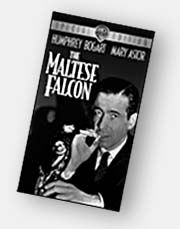|
Film Noir • Characteristics
• The Films
 FILM
NOIR FILM
NOIR
Film noir is a unique body of
works in American film history. As Alain Silver writes in
his introduction to Film Noir Reader, "film
noir is a self-contained reflection of American culture
and its preoccupations at a point in time."1
That point in time was the turbulent wartime decade of the
1940s – a decade in which Americans experienced contradictory
feelings of great success and optimism mixed with new and
unsettling changes at home and abroad.
After World War II ended, American films that had been made
during the war years began to make their way to Europe. A
small, but influential group of French critics – perhaps
because they saw the films with a fresh eye and almost as
a unit – recognized a new darkness in mood, style, and
theme that hadn't been present in films made before the war.
FRENCH CRITICS
R. Barton Palmer, who translated several
of the original essays written by these critics for his book,
Perspectives on Film Noir, notes in his introduction
that "the just-released films from America were scanned
closely for what they had to say about developments in the
political and cultural life of an esteemed ally."2
In addition to Nino Frank, who is credited with first using
the term film noir in print to describe the films,
others such as Raymonde Borde and Etienne Chaumeton examined
not only the sense of violence, but also the moral uncertainty,
cynicism, and off-balance mood they found in these new American
films.
In their 1955 essay, "Toward the
Definition of Film Noir," Borde and Chaumeton
observed that even more than from the characteristic violence,
"feelings of anguish arise from the unforeseen haphazardness
that characterizes the course of events."3
PAUL SCHRADER:
"Notes on Film Noir"4
The theme of American angst is echoed by Paul Schrader in
his widely-quoted essay, "Notes on Film Noir."
Writing in 1972, Schrader described how the narrative structure,
themes, and visual component in film noirs combined
to give a bleak look at America, noting that "never before
had films dared to take such a harsh, uncomplimentary look
at American life, and they would not dare to do so again for
twenty years."
Schrader discusses major influences on film noir,
with a disclaimer that "almost every critic has his own
definition of film noir, and a personal list of film titles...
How many noir elements does it take to make a film
noir noir?"
He argues, as do others, that film noir is not a genre,
but rather is defined by more subtle stylistic qualities of
tone and mood. He emphasizes that film noir is "a
specific period of film history" and encompasses Hollywood
films of the 1940s and early 50s which portrayed a world of
"dark, slick city streets, crime and corruption."
Schrader finds four catalytic elements – all of which
came together in America during the decade of the 1940s –
that influence film noir and give it its dark and cynical
tone: 1) war and postwar disillusionment 2)
postwar realism 3) German expressionism
and 4) the "hard-boiled" tradition.
A PARTICULAR PLACE AND TIME
Like Schrader, many critics see film
noir as a mixture of elements found in America during
the 1940s. In Movie-Made America, Robert Sklar notes
that film noir, in a narrow sense, refers to the "psychological
thrillers that emerged at the time of the war," many
of which were directed by a new generation of European expatriates
who had arrived in Hollywood.5
Brian Neve argues in Film and
Politics in America that although film noir was
perhaps not evidence of a national postwar zeitgeist,
it still invites examination as a study of the anxieties that
existed in at least part of society. He acknowledges that
"while film noir does seem to reflect – from
somewhere – a cynicism about the family relationships
held in such esteem in polite society, a pessimism more appropriate
to a self-conscious 'age of anxiety,' and even a visual style
more in keeping with a modernism spread by the new commercial
culture, it is still difficult to account for the tendency
in precise terms."6
A hallmark of film noir,
as Sklar indicates is a sense of "people trapped –
trapped in webs of paranoia and fear, unable to tell guilt
from innocence, true identity from false." Mirroring
the contradictory uncertainties found in wartime and postwar-America,
he states, "In the end, evil is exposed, though often
just barely, and the survival of good remains trouble and
ambiguous."7
Sklar and others remark upon the fact
that these feelings of claustrophobia and entrapment are found
in pictures quite distinct from classic film noir.
Jon Tuska argues in Dark Cinema: American Film Noir in
Cultural Perspective that because film noir is
a style and narrative structure, not a genre, it cuts across
generic lines.8
Evidence of film noir is often noted in gangster films
such as White Heat (1949), westerns such as Pursued
(1947), and comedies such as Arsenic and Old Lace (1944).
While there is not a universal agreement among critics about
what films constitute film noir, there are certain
characteristics about the films – the mood of darkness,
violence, and ambiguity – that are undisputed.
Return to Top • Characteristics
• The Films
|


